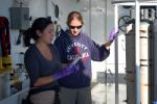(Press-News.org) Is the expansion of the universe accelerating for some unknown reason? This is one of the mysteries plaguing astrophysics, and somewhere in distant galaxies are yet-unseen supernovae that may hold the key. Now, thanks to a telescope calibrated by scientists from the National Institute of Standards and Technology (NIST), Harvard University and the University of Hawaii, astrophysicists can be more certain of one day obtaining an accurate answer.
The NIST scientists traveled to the summit of Haleakala volcano in Hawaii to fine-tune the operation of billions of light-collecting pixels in the Pan-STARRS telescope, which scans the heavens for Type IA supernovae. These dying stars always shine with the same luminosity as other Type IA supernovae, making them useful to observers as "standard candles" for judging distance in the universe. Any apparent shift in the supernova's spectrum gives a measure of how the universe has expanded (or contracted) as the light traveled from the supernova to Earth.
Because Type IA's are valuable as signposts, astrophysicists want to be sure that when they observe one of these faraway stellar cataclysms, they are getting a clear and accurate picture—particularly important given the current mystery over why the rate of expansion of the universe appears to be increasing. For that, they need a telescope that will return consistent information about supernovae regardless of which of the roughly 1,400,000,000 pixels of its collector spots it.
"That's where we came in," says NIST's John Woodward. "We specialize in measurement, and they needed to calibrate the telescope in a way that has never been done before."
Ordinary calibrations involve a telescope's performance at many light wavelengths simultaneously, but Pan-STARRS needed to be calibrated at many individual wavelengths between 400 and 1,000 nanometers. For the job, Woodward and his colleagues used a special laser whose wavelength can be tuned to any value in that range, and spent three days testing the telescope's huge 1.4 gigapixel camera–the largest in the world, Woodward says.
"Pan-STARRS will scan the same areas of the sky repeatedly over many months," Woodward says. "It was designed to look for near-Earth objects like asteroids, and it also pulls double duty as a supernova hunter. But for both jobs, observers need to be sure they can usefully compare what they see from one image to the next."
Woodward says that because this is one of the first-ever such calibrations of a telescope, it is unclear just how much effect the team's work will have, and part of their future work will be determining how much they have reduced the uncertainties in Pan-STARRS's performance. They will use this information to calibrate a much larger telescope–the Large Synoptic Survey Telescope, planned for construction in Chile.
INFORMATION:
* C.W. Stubbs, P. Doherty, C. Cramer, G. Narayan, Y.J. Brown, K.R. Lykke, J.T. Woodward and J.L. Tonry. Precise throughput determination of the Pan-STARRS telescope and the gigapixel imager using a calibrated silicon photodiode and a tunable laser: Initial results. Astrophysical Journal Supplement, Dec. 2010, Pages 376-388.
NIST telescope calibration may help explain mystery of universe's expansion
2011-01-07
ELSE PRESS RELEASES FROM THIS DATE:
IPv6 guide provides path to secure deployment of next-generation Internet protocol
2011-01-07
As the day draws nearer for the world to run out of the unique addresses that allow us to use the Internet—now predicted to happen by the end of 2012—researchers at the National Institute of Standards and Technology (NIST) have issued a guide for managers, network engineers, transition teams and others to help them deploy the next generation Internet Protocol (IPv6) securely.
Guidelines for the Secure Deployment of IPv6 (NIST Special Publication 800-119), describes the features of IPv6 and the possible related security impacts, provides a comprehensive survey of mechanisms ...
2 publications recommend organization-wide IT security risk management
2011-01-07
Two new draft publications from the National Institute of Standards and Technology (NIST) provide the groundwork for a three-tiered risk-management approach that encompasses computer security risk planning from the highest levels of management to the level of individual systems. The draft documents have been released for public comment.
Both publications are a part of NIST's risk management guidelines, which have been developed in support of the Federal Information Security Management Act (FISMA), and adopted government wide to improve the security of government systems ...
Princeton scientists construct synthetic proteins that sustain life
2011-01-07
In a groundbreaking achievement that could help scientists "build" new biological systems, Princeton University scientists have constructed for the first time artificial proteins that enable the growth of living cells.
The team of researchers created genetic sequences never before seen in nature, and the scientists showed that they can produce substances that sustain life in cells almost as readily as proteins produced by nature's own toolkit.
"What we have here are molecular machines that function quite well within a living organism even though they were designed ...
High dietary fat, cholesterol linked to increased risk of breast cancer
2011-01-07
(PHILADELPHIA) Elevated fat and cholesterol levels found in a typical American-style diet play an important role in the growth and spread of breast cancer, say researchers at the Kimmel Cancer Center at Jefferson.
The study, published in the January issue of The American Journal of Pathology, examines the role of fat and cholesterol in breast cancer development using a mouse model. The results show that mice fed a Western diet and predisposed to develop mammary tumors, can develop larger tumors that are faster growing and metastasize more easily, compared to animals eating ...
Drinking recycled water?
2011-01-07
Madison, WI December 28, 2010 – The Australian Government National Water Commission funded a study to establish an approach to assess the quality of water treated using managed aquifer recharge. Researchers at Australia's CSIRO Land and Water set out to determine if the en product would meet standard drinking water guidelines.
At the Parafield Aquifer Storage, Transfer and Recovery research project in South Australia, the team of scientists harvested storm water from an urban environment, treated it in a constructed wetland, stored it in an aquifer, and then recovered ...
Fermi's Large Area Telescope sees surprising flares in Crab Nebula
2011-01-07
Menlo Park, Calif. — The Crab Nebula, one of our best-known and most stable neighbors in the winter sky, is shocking scientists with a propensity for fireworks—gamma-ray flares set off by the most energetic particles ever traced to a specific astronomical object. The discovery, reported today by scientists working with two orbiting telescopes, is leading researchers to rethink their ideas of how cosmic particles are accelerated.
"We were dumbfounded," said Roger Blandford, who directs the Kavli Institute for Particle Astrophysics and Cosmology, jointly located at ...
NOAA-led team measures atmosphere's self-cleaning capacity
2011-01-07
An international, NOAA-led research team took a significant step forward in understanding the atmosphere's ability to cleanse itself of air pollutants and some other gases, except carbon dioxide. The issue has been controversial for many years, with some studies suggesting the self-cleaning power of the atmosphere is fragile and sensitive to environmental changes, while others suggest greater stability. And what researchers are finding is that the atmosphere's self-cleaning capacity is rather stable.
New analysis published online today in the journal Science shows that ...
UCSB, Texas A&M scientists find methane gas concentrations have returned to near-normal levels
2011-01-07
(Santa Barbara, Calif.) –– Calling the results "extremely surprising," researchers from the University of California, Santa Barbara and Texas A&M University report that methane gas concentrations in the Gulf of Mexico have returned to near normal levels only months after a massive release occurred following the Deepwater Horizon oil rig explosion.
Findings from the research study, led by oceanographers John Kessler of Texas A&M and David Valentine of UCSB, were published today in Science Xpress, in advance of their publication in the journal Science. The findings show ...
Freshwater methane release changes greenhouse gas equation
2011-01-07
AMES, Iowa – An international team of scientists has released data indicating that greenhouse gas uptake by continents is less than previously thought because of methane emissions from freshwater areas.
John Downing, an Iowa State University professor in the ecology, evolution and organismal biology department, is part of an international team that concluded that methane release from inland waters is higher than previous estimates.
The study, published in the journal Science, indicates that methane gas release from freshwater areas changes the net absorption of greenhouse ...
Web-based curriculum improves surgical residents' knowledge of health care business
2011-01-07
CHICAGO (January 6, 2011) – According to a report published in the December issue of the Journal of the American College of Surgeons, surgery residents improved their knowledge of health care business concepts and principles with the use of a Web-based curriculum.
The expectation is for residents to "demonstrate an awareness of and responsiveness to the larger context and system of health care, as well as the ability to call effectively on other resources in the system to provide optimal health care." However, consensus from residents is that they lack instruction and ...


